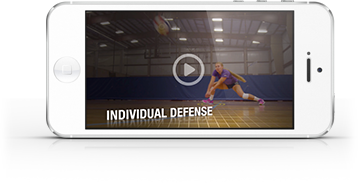Proper volleyball hitting form is crucial for hitters to jump high, attack with power and put the ball where they want without making errors.
Read on for seven common volleyball hitting mistakes and corrections courtesy of Bill Neville, a former U.S. and Canada Olympic coach. Learn how to hit a volleyball correctly by taking note of these common errors and corrective actions.
Read more: Basic Volleyball Rules and Fundamentals
Error #1: Player's approach footwork is backwards (known as "goofy footing")
Correction: Have the player focus on their arms as they work with their legs. For right-handers, their hands should go forward with the left step and back with the right (opposite for left-handers.) For goofy footers, arms should go in reverse.
Error #2: Player is too far under the ball and must reach back to hit
Correction: Young players tend to either A) not get far enough off the net to affect a full approach or B) leave too early, feeling that they will be too late.
In situation A, emphasize and reinforce getting available and staying available. Try incorporating a visual aid by putting a mark on the floor or using a traffic cone to show how far back the player must go.
Situation B is more challenging; the height, velocity and location of the set changes with each repetition.
Important: Per motor learning principles, learning happens when players practice the skill specifically as it applies to the game. Spiking and perfecting timing requires hitting a moving ball, so suspending a ball from a piece of equipment or holding it above the net will not teach effective volleyball hitting form.
Slowly progress from simple to complex approaches, and use the Socratic Method of asking players what is triggering the approach. Direct their attention to the ball leaving the setter's hands and visualizing trajectory, velocity and location. Some players will pick up recognition and timing easily while others may struggle. Be patient — repeat, deliberate practice in a variety of situations will yield positive results. Give players time to get comfortable with the previous challenge.
Error #3: Right-handed player gets their left shoulder (opposite for left-handers) beyond the point of attack so that the only shot available is a cross body arm swing
Correction: Study the second to last step of the approach. For right-handers, the second-to-last step must be fast, long and low. The last step must be short and quick, and convert the explosive horizontal approach to a vertical launch.
If the second-to-last step is short, the final step will fall beyond the desired launch point. Instead of going vertically, the player’s weight will shift horizontally toward the net, with the left shoulder going beyond the point of attack.
Error #4: Player constantly hits the net after hitting the ball
Correction: The setter needs to keep the ball further off the net, and the hitter needs to launch vertically and further back from the net. When the hitter is close to the net, the arm swing should stop after contact instead of completely following through. The hitting hand should snap like a whip.
Error #5: Player is stiff and decelerates on approach
Correction: Encourage your players to be intense, but not tense. Spiking is a powerful, explosive, series of coordinated movements, whereas attacking is a relaxed, whipping motion.
On the first two steps, the hands should be relaxed and swinging naturally, staying below the waist. If the hitter is raising their hands, they will raise the center of gravity, thus slowing down the approach. Relax the fingers, hands, wrists and shoulders to allow the whip to accelerate.
Error #6: Hitter keeps hitting ball long
Correction: This is a common result of the previously described issues. Hitters will naturally correct this volleyball hitting mistake by working on the above solutions.
Error #7: Hitter keeps hitting the ball into the net
Correction: This problem is usually due to jumping ability, height and length of arms. But we can't teach players how to grow, so we must accommodate their physical capabilities. A shorter player should work on their jumps, and improve their relative position to the set. Also, the player must focus on keeping the hitting hand up after contact.
How to Hit a Volleyball Correctly
By understanding common spiking errors and learning how to hit a volleyball properly, hitters can improve their strategy, jump high and attack with power. Here are our top tips for hitting a volleyball correctly:
- Footwork: Develop each player’s approach footwork so it’s consistent every time. This could be a 3-step (left, right, left for a right-hander) or 4-step (right, left, right, left) approach. Wait and accelerate through the approach (the last two steps should be the fastest).
- Timing: The first step determines the angle of the approach and is the “locator step.” The second step is a quick, low step. The third and last step is parallel to the second step and helps load for the jump.
- Arm swing: Like with a tennis serve, power is generated with hip and shoulder rotation as the hitter swings. Hip rotation starts the action, then the body follows and pulls the elbow forward. Your hand trails your elbow and you bend at the elbow, causing your forearm to be a whip. Finish with a high snap if you’re hitting for accuracy, and for full power, your hitting shoulder finishes past your non-hitting shoulder.
- Landing: Train hitters to land with both feet and land balanced. Hitters should land like an accordion, bending their legs on impact to cushion their bodies.
- Approach angle: Teach attackers to adjust their approach-angle based on the pass and set. Many hitters adjust to different set locations by moving their shoulders, but this puts you at greater risk for injuries and also leads to more attacking errors. Learning how to locate the ball so you can plant at the right spot and contact the ball directly over your hitting shoulder is one of the key skills of attacking.
Watch this quick video to see how some of these tips look in action on the court:
Teach players how to hit a volleyball like a pro
Looking for more drills, tips and tricks to improve hitting skills? Check out Volleyball Hitting Drills from The Art of Coaching Volleyball.
And if you’re a volleyball coach, be sure to take a look at our Volleyball Coaches Handbook, which features 300 pages of lectures, drills and worksheets from 5 years of our best clinic sessions. Check it out here!



